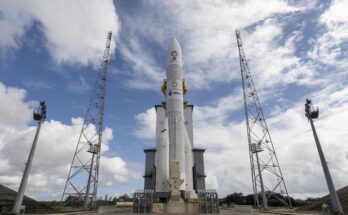A Russian Soyuz 2.1b launch vehicle carried a GLONASS-M navigation satellite into orbit from the Plesetsk Space Center in northern Russia on November 3, 2018 at 11:17 p.m. Moscow Time (8:17 p.m. UTC; 4:17 p.m. EDT). Russian news agency TASS reported that the upper stage successfully separated from the third stage 11 minutes after liftoff.
GLONASS-M satellites began launching in 2001. The satellites have a seven-year lifespan and transmit in L3 signals. Russia has introduced a newer variant of the GLONASS satellite that features increased international interoperability and a longer lifespan. However, Moscow continues to purchase GLONASS-M spacecraft.
While GLONASS fell into disrepair during the 1990s after years of neglect, Putin began an effort to revitalize the system in the early 2000s. This led to increased production rates between 2006 and 2011. During that time, an average of four satellites was delivered per year. The system was finally declared operational in December 2011, with 24 operational satellites along with a number of in-orbit spares. Although the system briefly fell below 24 satellites after a 2013 Proton launch failure, it was brought back up to 24 shortly after that and has remained at that figure since then.
With the system is operational, production rates have declined as satellites are produced to maintain the system rather than to increase the number of spacecraft in orbit. While 14 satellites were launched in 2010 and 2011, no satellites were launched in 2012 and between 2013 and 2017, an average of two satellites were delivered per year. Production will likely remain at about two per year over the next decade.
A military history enthusiast, Richard began at Forecast International as editor of the World Weapons Weekly newsletter. As the Internet grew in importance as a research tool, he helped design the company's Forecast Intelligence Center and currently coordinates the EMarket Alert newsletters for clients. Richard also manages social media efforts, including two new blogs: Defense & Security Monitor, covering defense systems and international issues, and Flight Plan, which focuses on commercial aviation and space systems. For over 30 years, Richard has authored the Defense & Aerospace Companies, Volume I (North America) and Volume II (International) services. The two books provide detailed data on major aerospace and defense contractors. He also edits the International Contractors service, a database that tracks all the contractors involved in the programs covered in the FI library. More recently he was appointed Manager, Information Services Group (ISG), a new unit that encompasses developing outbound content for both Forecast International and Military Periscope.



